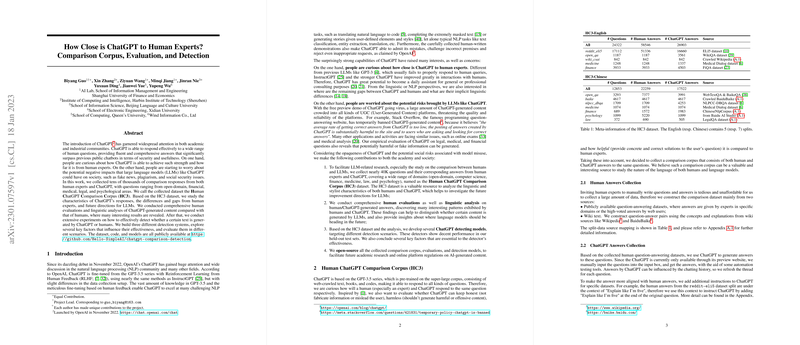Overview of "How Close is ChatGPT to Human Experts? Comparison Corpus, Evaluation, and Detection"
This paper presents a critical examination of ChatGPT, assessing its proximity to human expertise across various domains and exploring methods for distinguishing AI-generated content. The research aims to illuminate the qualitative differences between ChatGPT and human experts and investigates effective strategies for detecting AI-generated text.
Human ChatGPT Comparison Corpus (HC3)
A significant contribution of the paper is the Human ChatGPT Comparison Corpus (HC3), a dataset comprising nearly 40,000 questions with answers from both ChatGPT and human experts. The dataset spans multiple areas including open-domain, finance, medicine, law, and psychology, facilitating comprehensive analysis and comparison.
Evaluation and Analysis
Human Evaluation
Four distinct tests were conducted, namely:
- Expert Turing Test (Paired and Single Text): Experts analyzed paired and single responses, distinguishing between human and AI output.
- Amateur Turing Test (Single Text): Non-experts assessed individual responses to determine AI origins.
- Helpfulness Test: Evaluated perceived helpfulness of responses to assess practical utility.
Results indicated that experts performed better in distinguishing AI text compared to amateurs. Additionally, ChatGPT responses were often considered more helpful, except in specific domains like medicine.
Linguistic Analysis
The paper undertakes a detailed linguistic analysis, revealing key differences between human and AI-generated text:
- Vocabulary Use: Human responses exhibited greater vocabulary diversity, while ChatGPT responses were lengthier yet more restricted lexically.
- Part-of-Speech and Dependency Parsing: ChatGPT favors structured, formal language with a tendency toward neutrality, while human text is more colloquial and emotionally expressive.
- Sentiment: ChatGPT generates text with less emotional variance, contrasting with the more sentimentally dynamic human responses.
- Perplexity Analysis: ChatGPT-generated text generally had lower perplexity scores, reflecting more predictable linguistic patterns characteristic of AI training data.
Detection Systems
To address the challenge of AI-generated content, the paper develops several detection models, including:
- Logistic Regression using GLTR Features: Utilizes token probability features to distinguish AI text.
- RoBERTa-based Models: Employs deep learning techniques for single-text and QA-style detection.
The models are evaluated across different text granularities (full-text and sentence-level) and reveal that detection is more challenging at the sentence level. Additionally, models trained to recognize sentence-level patterns displayed improved robustness.
Implications and Future Directions
The research highlights the nuanced differences between ChatGPT and human experts, underscoring areas where AI can enhance utility, such as providing detailed information consistently. However, it also acknowledges potential risks, including misinformation. The detection systems developed provide practical tools for mitigating these risks.
Future research is advised to explore broader datasets and specialized prompts to determine their impact on detection efficacy. The work lays the groundwork for future advancements in AI accountability and explains the importance of continuously evolving detection methods to keep pace with AI technology advancements.
In sum, the research offers a comprehensive framework for understanding and evaluating AI capabilities relative to human expertise, while providing practical tools to identify and manage AI-generated content in various applications.
